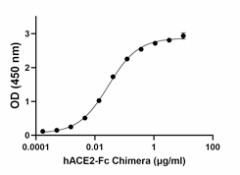- Regulatory Status
- RUO
- Other Names
- Coronavirus spike Protein RBD, S1 RBD, Spike Protein RBD, Mink variant

-

When recombinant SARS-CoV-2 Mink Variant RBD is immobilized at 2 μg/mL, recombinant human ACE2-Fc Chimera (Cat. No. 793202) binds in a dose-dependent manner. The ED50 for this effect is 10 – 50 ng/mL. HRP Protein A (Cat. No. 689202) was used to detect the binding. -

Stability Testing for Recombinant SARS-CoV-2 Mink Variant RBD. Recombinant SARS-CoV-2 Mink Variant RBD was aliquoted in PBS at 0.2 mg/mL. One aliquot was frozen and thawed four times (4x Freeze/Thaw), and compared to a control kept at 4⁰C (Control). The samples were tested by their ability to bind recombinant human ACE2-Fc chimera in a dose dependent-manner. The ED50 for this effect is 10 – 50 ng/mL.
| Cat # | Size | Price | Quantity Check Availability | ||
|---|---|---|---|---|---|
| 797104 | 25 µg | $411.00 | |||
| 797106 | 100 µg | $932.00 | |||
SARS-CoV-2 is a respiratory virus which causes coronavirus disease 2019 (COVID-19). The coronavirus spike (S) glycoprotein is a class I viral fusion protein on the outer envelope of the virion that plays a critical role in viral infection by recognizing host cell receptors and mediating fusion of the viral and cellular membranes. The S glycoprotein is synthesized as a precursor protein consisting of ~1,300 amino acids that is then cleaved into an amino (N)-terminal S1 subunit (~700 amino acids) and a carboxyl (C)-terminal S2 subunit (~600 amino acids). Three S1/S2 heterodimers assemble to form a trimer spike protruding from the viral envelope. The S1 subunit contains a receptor-binding domain (RBD) that can specifically bind to angiotensin-converting enzyme 2 (ACE2), the receptor on target cells. Triggered by receptor binding, proteolytic processing, and/or acidic pH in the cellular compartments, the class I viral fusion protein undergoes a transition from a metastable pre-fusion state to a stable post-fusion state during infection. During this, the receptor-binding subunit is cleaved, and the fusion subunit undergoes large-scale conformational rearrangements to expose the hydrophobic fusion peptide, inducing the formation of a six-helix bundle, bringing the viral and cellular membranes close for fusion. The trimeric SARS coronavirus (SARS-CoV-2) S glycoprotein consisting of three S1-S2 heterodimers binds the cellular receptor angiotensin-converting enzyme 2 (ACE2) and mediates fusion of the viral and cellular membranes through a pre- to post-fusion conformation transition. SARS-CoV-2 Mink variant was initially identified by mink farmers in Denmark. Mink variant has the mutations Y453F/D614G and presents an increased affinity for human ACE2. The SARS-CoV-2 Mink variant represents a model of sarbecovirus interspecies evolution.
Product Details
- Source
- SARS-CoV-2 Mink Variant RBD amino acid Arg319-Phe541 (Accession # QHD43416.1), with a C-terminal 8His tag was expressed in CHO cells.
- Molecular Mass
- The 234 amino acid recombinant protein has a predicted molecular mass of approximately 26.3 kD. The DTT-reduced and non-reduced proteins migrate at approximately 35 kD and 30 kD by SDS-PAGE, respectively. The predicted N-terminal amino acid is Arg.
- Purity
- > 95%, as determined by Coomassie stained SDS-PAGE.
- Formulation
- 0.22 µm filtered protein solution is in PBS, pH 7.2.
- Endotoxin Level
- Less than 0.1 EU per µg protein as determined by the LAL method.
- Concentration
- 25 µg size is bottled at 200 µg/mL. 100 µg size and larger sizes are lot-specific and bottled at the concentration indicated on the vial. To obtain lot-specific concentration and expiration, please enter the lot number in our Certificate of Analysis online tool.
- Storage & Handling
- Unopened vial can be stored between 2°C and 8°C for up to 2 weeks, at -20°C for up to six months, or at -70°C or colder until the expiration date. For maximum results, quick spin vial prior to opening. The protein can be aliquoted and stored at -20°C or colder. Stock solutions can also be prepared at 50 - 100 µg/mL in appropriate sterile buffer, carrier protein such as 0.2 - 1% BSA or HSA can be added when preparing the stock solution. Aliquots can be stored between 2°C and 8°C for up to one week and stored at -20°C or colder for up to 3 months. Avoid repeated freeze/thaw cycles.
- Activity
- When recombinant SARS-CoV-2 Mink Variant RBD is immobilized at 2 μg/mL, recombinant human ACE2-Fc Chimera (Cat. No. 793202) binds in a dose-dependent manner. The ED50 for this effect is 10 – 50 ng/mL. HRP Protein A (Cat. No. 689202) was used to detect the binding.
- Application
-
Bioassay
- Application Notes
-
BioLegend carrier-free recombinant proteins provided in liquid format are shipped on blue-ice. Our comparison testing data indicates that when handled and stored as recommended, the liquid format has equal or better stability and shelf-life compared to commercially available lyophilized proteins after reconstitution. Our liquid proteins are validated in-house to maintain activity after shipping on blue ice and are backed by our 100% satisfaction guarantee. If you have any concerns, contact us at tech@biolegend.com.
Antigen Details
- Structure
- Monomer
- Distribution
-
SARS-CoV-2
- Function
- Attaches the virion to the cell membrane by interacting with host receptor (ACE2), initiating the infection
- Interaction
- Ciliated cells in nasal mucosa and bronchus, pneumocytes
- Ligand/Receptor
- ACE2
- Bioactivity
- Measured by its ability to bind to recombinant human ACE2-Fc chimera
- Cell Type
- B cells, Endothelial cells, Macrophages, Monocytes, NK cells, T cells, Th1
- Biology Area
- Adaptive Immunity, Immunology, Innate Immunity
- Antigen References
-
- Lu R, et al. 2020. Lancet. 395:565-574.
- Li F. 2016. Annu Rev Virol. 3:237-61.
- Belouzard S, et al. 2012. Viruses. 4(6):1011-33.
- Song W, et al. 2018. PLoS Pathog. 14:e1007236
- Li F, et al. 2020. Nature. 581:221-4.
- Gene ID
- 43740568 View all products for this Gene ID
- UniProt
- View information about Spike RBD on UniProt.org
